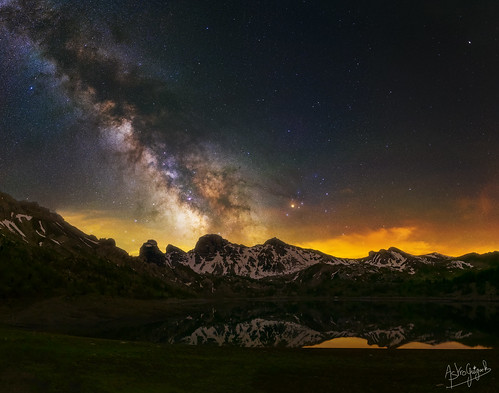Lights from ... our Distorted Sun
Every sunset is inherently fascinating. When the Sun reaches its lowest elevation over the Horizon, the atmospheric-optics show can start! Here are 10x10 different views of our Star at Sunset captured from Chile during 18 different sunsets. Every picture is extracted from a real-time video footage, and resized to 1000 x 800 pixels.
This project was initially thought to be a real-time green flash compilation video. You can watch the associated video at this link or just below: https://youtu.be/ht9bCJT2SV4
Both the video and this image show almost all types of green flashes, blue flashes, green and red rims, inferior / superior mirages, and even a rare mirage called the Novaya Zemlya effect [from picture n°8 to picture n°15, reading up to down and left to right direction]. This latter effect is when the sun is still visible whereas it has been theoretically under the horizon for few minutes.
What is a Green Flash or a Blue Flash?
Green flash remains undoubtedly the most impressive and popular atmospheric phenomena that sky explorers are fans of. A green flash requires two separate phenomena in order to be formed :
- first, a mirage which is produced by a gradient of temperature throughout the layers of the atmosphere from ocean level to sky level. It affects the refractive index of air layers and causes the light beams to change their trajectory until the refraction stops and only total reflection remains.
- Second, the prism effect which happens to deviate every single color of sunlight in a specific way as a white light-beam is decomposed through a prism. This effect is more noticeable as the sunlight crosses a broader section of Earth's Atmosphere. The dispersion of light is then higher and creates several color images of the Sun at sunset. The two opposite colors of the solar spectrum are Red and blue. The shorter wavelengths (blue) are the most affected by atmospheric dispersion whereas the longer (red) are the least ones. Therefore a blue flash will always occur at the top of the solar disk. However, as blue is heavily scattered by Earth's atmosphere, a green rim is more likely to be seen.
The mirage effect added to the green rim effect (dispersion) enables to detach this green limb at the upper side of the sun's disk, producing a so-called green flash.
Technical Details....
Here, I only selected the best views of the Sun: Among these 100 pictures of sun mirages, 50 of them are green flashes, and 4 are blue flashes.
This unusual 10x10 mosaic of our neighbor star is the result of a difficult and long work! It gathers no less than 18 different sunsets taken from La Serena (Chile) over the Pacific Ocean, over a period of 4 months (from May to August 2018). Pictures of a same sunset are following each other (from left to right, and from top to bottom). As it was winter in southern hemisphere, the weather wasn’t always suitable and almost 50% of the time, the horizon was cloudy.
→ Canon Rebel T5i camera (movie mode)
→ Tamron USD Vi 70-300 mm zoom lens + digital zoom varying from 3x to 10x
→ Sky-Watcher Star Adventurer MINI tracking mount (for azimut-motorized axis)
→ Standard Tripod
→ Focal length: 300 mm (~480 mm on APS-C sensor)
→ Full HD recording
→ Aperture from F/7.1 to F/11







No comments:
Post a Comment
Feel free to drop me a comment!